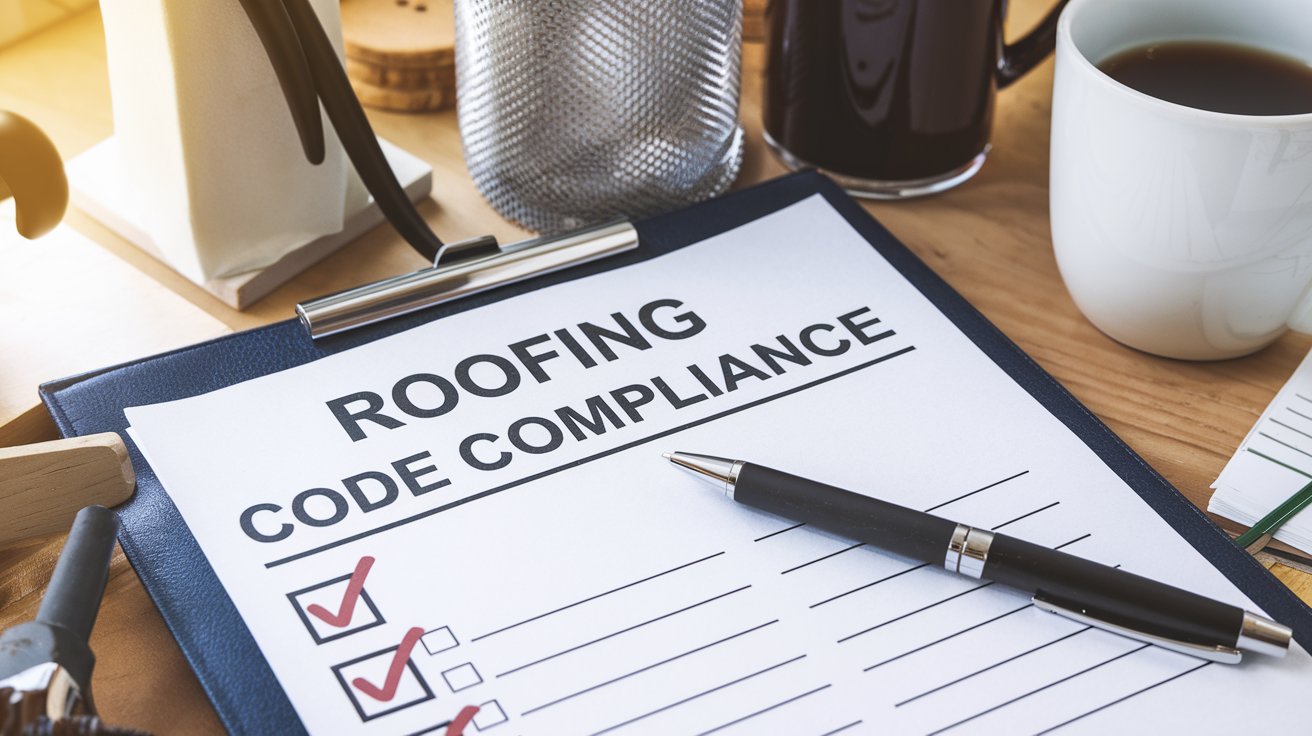Building Code Compliance: Essential Guide to Roofing Regulations 2024
Every year, thousands of homeowners face costly fines and insurance claim denials due to roofing code violations. With some penalties reaching six figures and many insurers limiting coverage for non-compliant roofs, understanding building codes and roofing regulations has never been more critical. These regulations, established by state and local governments, set essential standards for everything from construction materials to maintenance procedures, directly impacting your home's safety and value.
Whether you're planning a roof replacement or maintaining your current one, navigating these complex regulations can feel overwhelming. Building codes affect every aspect of your roof's lifecycle - from initial design to ongoing maintenance. They determine which materials you can use, how they must be installed, and even influence your insurance premiums. Non-compliance can result in significant financial penalties and void your insurance coverage.
In this comprehensive guide, you'll learn how to navigate local building codes, understand key compliance requirements, and protect your investment. We'll explore practical strategies for working with contractors, maintaining proper documentation, and ensuring your roof meets all necessary standards. By the end, you'll have the knowledge needed to make informed decisions about your roof while staying compliant with local regulations.
- Key Roofing Code Requirements
- Navigating Local Roofing Regulations
- Ensuring Compliance in Your Roofing Projects
- Impact of Building Codes on Homeowners' Insurance
Introduction to Building Codes and Roofing Regulations
Understanding building codes and roofing regulations is crucial for both homeowners and contractors. These codes, typically established by state or local governments, define the standards for building design, construction, modification, and overall performance. These codes dictate everything from allowed construction materials to required maintenance procedures. Building codes prioritize safety, energy efficiency, and environmental sustainability, ensuring structures can withstand natural hazards and meet stringent safety requirements. Non-compliance can result in substantial legal and financial penalties, sometimes reaching six figures. This introduction will explore the importance of compliance and provide a general overview of relevant building codes and regulations.
Importance of Compliance for Homeowners
Complying with building codes and roofing regulations protects homeowners' property and finances. Code violations can have lasting consequences, including significant fines. Non-compliance can also void insurance claims, as many insurers require adherence to local regulations to minimize risks and control claim costs. Compliance safeguards homeowners from potential hazards and preserves their property's value. Accurate reporting of a roof's age is also essential for proper risk assessment and insurance premium calculations. Regular roof inspections, while not always mandatory, can identify potential issues early, ensuring compliance and preventing costly problems. Consider scheduling a Get Your Roof Assessment to help maintain your roof and ensure it meets current regulations.

Overview of Building Codes and Regulations
Building codes and roofing regulations cover a wide range of requirements aimed at ensuring structural safety and integrity. These codes address aspects like structural strength, fire resistance, and permitted materials. They protect both building occupants and construction workers. Every U.S. state adopts building codes for roofing projects. For instance, California's building codes emphasize energy efficiency and environmental sustainability, often including requirements for "cool roofs," designed to reflect sunlight and reduce heat absorption. Cool roofs can lower energy costs and extend roof lifespan. Learn more about roof maintenance to understand how these regulations impact your home. The International Code Council publishes reports ranking common commercial building code violations, providing valuable insights for contractors and builders. Understanding these regulations is crucial for anyone involved in construction or renovation projects to ensure compliance with safety and performance standards.
Key Roofing Code Requirements
Understanding roofing code requirements is crucial for both homeowners and contractors. Following these codes ensures safety, durability, and compliance with local regulations. These codes, adopted by every state, protect both occupants and the structure itself from various hazards. They cover essential aspects like structural integrity, materials, and fire safety. Building codes provide detailed standards for design, construction, alterations, materials, maintenance, and building performance. This comprehensive approach means everything from the initial plans to ongoing maintenance must adhere to these rules. Let's explore the key roofing code requirements you need to know. This knowledge will help you maintain compliance and extend the life of your roof. Consider getting a roof assessment to ensure your roof meets these standards.

Structural Integrity and Load Requirements
Roofing codes prioritize structural integrity. Roofs must withstand various loads, including snow, wind, and rain. In areas with heavy snowfall, the ground snow load must be calculated, especially if it exceeds 10 pounds per square foot. This data helps engineers design roofs capable of handling the weight. Building codes often have criteria to evaluate a roof's structural integrity against current standards. This process may include inspections or engineering assessments, particularly for larger projects or renovations. These requirements help prevent roof collapses and other structural failures, protecting both the property and its occupants. Updated codes often enhance requirements for wind resistance and snow loads. They may also include new rules for rainwater collection. This means newer roofs will likely be built to higher standards. Learn more about roof maintenance and how these requirements impact your roof.
Material Specifications and Installation Standards
Roofing materials must meet specific standards for durability and performance. Asphalt shingles, for example, are only suitable for roof slopes of 17% or greater (a 2:12 slope). This means that for every 12 horizontal units (the run), the roof must rise at least 2 vertical units. Using asphalt shingles on shallower slopes can lead to water problems. Proper installation is also critical. This includes the correct use of underlayment and fasteners. Mistakes like missing nails, over-driven nails, or the wrong underlayment can compromise the roof. Standards like those from ASTM help ensure quality and longevity. ASTM standards specify, test, and evaluate various aspects of roofing materials. Providing accurate information about your roof's age is also essential. This information is crucial for risk evaluation and insurance premiums. Inaccurate information can lead to incorrect assessments. This is important because many insurers limit or exclude coverage for roofs over 20 years old.

Fire Safety and Weather Resistance
Fire safety is a key element of roofing codes. Regulations often mandate fire-resistant materials to slow the spread of flames. This focus on safety extends to aspects like emergency exits and fire suppression systems. Roofs must also be weather-resistant to protect against wind and hail. Industry data suggests that around 2.5% of insured homes experience property damage from wind or hail each year. This statistic underscores the importance of weather-resistant roofing. Roofing codes specify materials and construction methods to enhance weather resistance, minimizing damage and costly repairs. By adhering to these codes, homeowners can ensure their roofs are safe and resilient. Insurance companies also benefit from compliant roofs. This compliance helps mitigate risks, reduce claim costs, and improve customer satisfaction. Many government entities now include "cool roofs" in their building codes and energy efficiency programs. Cool roofs are designed to reflect sunlight and absorb less heat, improving energy efficiency and sustainability.
Understanding local roofing regulations is crucial for both homeowners and contractors. These regulations influence every aspect of a roofing project, from cost and timeline to permitted materials. City and municipal requirements vary, impacting project specifics. Building codes dictate design, construction methods, materials, and maintenance. Ignoring these regulations can result in costly fines and project delays. Knowing local codes ensures a smooth, legally sound roofing process.
How to Access Local Codes and Regulations
Accessing local codes is the first step towards compliance. Most cities have building departments or similar agencies that manage these codes. You can often find this information online or by contacting the local authorities. Official city websites and direct contact with building departments are good resources. Thoroughly review these documents to understand material, installation, and structural requirements. While you don't need to be a code expert, understanding the sections relevant to your project is key. Many states require contractor licensing or registration (27 require licenses, 13 require registration) to ensure familiarity with local regulations. This protects homeowners by guaranteeing a baseline contractor competency. For a comprehensive understanding of roof maintenance best practices, learn more about roof maintenance.
Common Regional Variations and Examples
Roofing regulations often vary regionally due to climate and historical building practices. Codes address unique local challenges. For example, areas with heavy snowfall may require roofs to withstand substantial snow loads, sometimes over 10 pounds per square foot. This impacts roof slope, framing, and sheathing. Coastal regions with high winds often have strict requirements for wind resistance and anchoring. Codes often address combined loads like snow and wind, requiring roofs to handle multiple stresses simultaneously. Some regions have adopted cool roof standards for energy efficiency and to combat urban heat islands. Cool roofs reflect more sunlight and absorb less heat. Many governments include them in building codes and energy programs. Understanding these regional differences is crucial for material selection and construction methods. For instance, asphalt shingles are typically only allowed on roofs with a 17% (or 2:12) slope or greater. To assess your roof's condition and ensure compliance, consider a Get Your Roof Assessment.

Case Studies of Compliance Challenges
Real-world examples illustrate compliance challenges. New York's strict roofing codes demand precise installation to avoid violations. Non-compliance can lead to significant fines and legal issues. Some homeowners have faced six-figure penalties for violations. California's building codes integrate energy efficiency standards, adding complexity for contractors and owners. These cases emphasize the need to understand and follow local regulations. Insurance companies consider compliance when assessing risk, and non-compliance can impact coverage. Most commercial insurers limit or deny coverage for roofs over 20 years old, underscoring the importance of maintenance and code adherence. Navigating local roofing regulations can seem complex, but with the right information, it becomes manageable. Understanding local codes, regional variations, and past challenges ensures your project meets requirements and avoids issues. Accurately reporting your roof's age is crucial for insurance evaluations and premiums.
Ensuring Compliance in Your Roofing Projects
Understanding building codes and roofing regulations is crucial for any roofing project. These regulations vary by location, impacting safety and costs. Building codes establish standards for materials, like asphalt shingles (which must be installed on roofs with a slope of 17% or greater), and structural integrity. These codes protect both occupants and construction workers by addressing fire resistance and structural performance. Compliance ensures safety, energy efficiency, and environmental sustainability. Many governments incorporate "cool roof" requirements into building codes and energy efficiency programs. Cool roofs reflect more sunlight and absorb less heat, reducing energy costs and combating the urban heat island effect.
Steps to Verify Code Compliance Before Starting
Verifying code compliance is crucial before starting any roofing project.
Research Local Codes
Begin by researching your area's specific building codes, which vary between states and municipalities. While all states have building codes, enforcement and specific regulations differ locally. Find local codes on your government's website or by contacting your city's building department.
Consult Relevant Codes and Amendments
Review the International Building Code (IBC) or International Residential Code (IRC), depending on your project, and any local amendments. Some local codes require roof structure evaluations based on factors like roof size or structural modifications. Consult local building departments for updates and specific requirements.
Leverage Roof Assessment Tools
Tools like our Get Your Roof Assessment can identify potential issues early, ensuring compliance and saving time and money.
Selecting Qualified Contractors and Inspectors
Choosing qualified contractors and inspectors is essential for compliance.
Contractor Qualifications
Many states require roofing contractors to be licensed or registered, with 27 states mandating licenses and 13 requiring registration. Verify credentials and check past project history. Experienced contractors understand local codes and can navigate challenges, including determining the need for material testing according to ASTM roofing standards.
Inspector Qualifications
Hiring a qualified inspector provides independent verification of compliance. Involve an inspector at different project stages: initial inspections, periodic checks, and a final inspection.
Understanding the Consequences of Non-Compliance
Non-compliance with roofing regulations has serious consequences.
Financial and Project Impacts
Non-compliance can lead to fines, delays, and rework, increasing project costs. Some homeowners have faced six-figure fines for code violations. Even after completion, corrections may be necessary.
Insurance and Legal Implications
Continued non-compliance can result in legal action or loss of insurance coverage, especially for older roofs. Building owners must provide accurate information about their roof's age to insurers. While a roof over 20 years old doesn't automatically void insurance, it increases the risk of limited coverage or claim denial. Discuss your roof's age and condition with your insurer. Learn more about roof maintenance. Understanding these risks highlights the importance of compliance from the start.
Impact of Building Codes on Homeowners' Insurance
Homeowners need to understand building codes and how they impact insurance. Building codes set the rules for everything from a building's design and construction to the materials used and necessary upkeep. State and local governments develop these codes for all buildings, both commercial and residential. These codes influence construction quality, safety, and efficiency, directly affecting insurance premiums and coverage. Not following these codes can lead to hefty fines and higher insurance costs. Some homeowners have even lost their homes due to six-figure fines related to code violations. Understanding and following building codes protects your home and impacts your insurance policy's terms and rates. This section explores the connection between building code compliance, insurance premiums, and necessary insurance documentation.
Following building codes is a big factor in determining homeowner's insurance premiums. Insurance companies consider a property's compliance with local building codes when assessing risk. These codes aim to ensure safety, health, resilience, and energy efficiency. Every state in the U.S. adopts building codes for roofing projects, though the specifics may differ between state and local areas. Homes meeting or exceeding these standards are typically seen as lower risk, leading to better insurance rates. Insurers recognize that homes built to code are better equipped to withstand damage from fires, storms, and other hazards. Homes not meeting code requirements may face higher premiums or even be denied coverage. For example, many insurers limit or exclude coverage for buildings with roofs over 20 years old. Older roofs are more likely to have code violations. Some local building codes require roofs to be reevaluated against current codes after a certain number of years. Following building codes can lower insurance costs and ensure proper coverage. Insurance companies also benefit from code compliance through reduced risks, lower claim costs, and improved customer satisfaction. Consider getting a Get Your Roof Assessment to ensure your roof meets current standards.
Documentation Required for Insurance Purposes
Accurate documentation is essential for homeowners seeking insurance coverage and competitive premiums. Insurance companies need information about a property's compliance with building codes. This includes details about construction materials, structural soundness, and any renovations or upgrades. Incorrect or incomplete information can lead to inaccurate risk assessments and premiums. Homeowners should keep records of building permits, inspection reports, and code compliance certificates. This documentation helps insurers verify adherence to local regulations. These records not only streamline the insurance process but also serve as proof of compliance if you need to file a claim. For instance, if hail damages your roof (about 1 in 40 insured homes files wind or hail damage claims annually), proof of proper, code-compliant roof installation can help expedite your claim. Up-to-date and accurate documentation avoids disputes with insurers and provides peace of mind. It's also worth noting that unlicensed work can void your homeowner's insurance, making you liable for future damages. To learn more about roof maintenance and ensure your compliance, explore our detailed guide.
Disclaimer: This blog post is intended for informational purposes only and should not be considered professional roofing advice. Always consult with qualified roofing contractors and insurance professionals for specific guidance regarding your individual circumstances.
